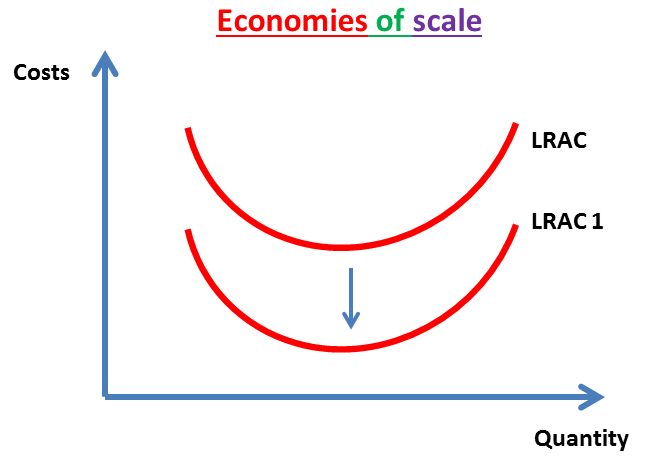Economies of scale (AS/A LEVELS/IB/IAL)
Economies of scale (AS/A LEVELS/IB/IAL)
Level: AS Levels, A Level, GCSE – Exam Boards: Edexcel, AQA, OCR, WJEC, IB, Eduqas – Economics Revision Notes
Economies of scale
Definition
As output increases there is a fall in long run average costs.
 Internal Economies of Scale
Internal Economies of Scale
Internal economies of scale arise when there is a decrease in long run average costs within a firm.
Types of economies of scale
Financial economies of scale
As a firm gets larger it’s able to access business loans more easily at lower rates of interest. This is because there is less risk associated with lending the firm money.
Risk-bearing economies of scale
As a firm becomes larger, it’s able to grow their product range. This allows them to diversify their risk as they are not relying on only one product or service to generate profits.
Marketing economies of scale
As a firm increases its product range, it’s able to market all its products under its brand/logo. For example Nike can make a generic advertisement promoting their logo. This would help to promote all their products through this one logo advertisement e.g. Trainers, jumpers, t-shirts, hats and backpacks.
Managerial economies of scale
As a firm expands, it’s able to afford more specialist managers in different areas of the business e.g. Human resources, sales, operations, finance etc. This helps the firm become more efficient and helps to decrease their costs of production further with the use of specialist managerial skills.
Technical economies of scale
As a firm expands, it’s able to afford better technology and capital equipment to help with the running of its operations. The more efficient the technology the lower the cost of production will be in the long run.
External economies of scale
This occurs due to a change in the industry. This would lower the entire LRAC curve of all the firms in this industry.
E.g. If the government builds a bridge to allow all local firms to reduce their travel times and costs.
AQA Spec – Additional Content
The relationship between Returns to Scale and Economies of Scale
When a firm benefits from Economies of Scale, it implies that their factor inputs are more productive and their Returns to Scale increases
LRAC Curve
This diagram shows the relationship between the SRAC Curve and the LRAC Curve
The LRAC Curve is always equal to or below the SRAC curve – it shifts when there are external economies of scale
Costs in the long run change due to economies and diseconomies of scale. However – in the short run – SRAC falls initially but then rises, due to diminishing returns
Firms can vary all factors of production if SRAC = LRAC
The L-Shaped Curve is a development from the U-Shaped curve, implying that costs per unit fall as output increases, as a result of Economies of Scale
Even if the pace of falling output costs is slower, costs will still fall in the long run. This is depicted by the flat part of the curve
The Economies of Scale gained by technical or production factors usually offsets the Diseconomies of Scale arising due to managerial factors
Quick Fire Quiz – Knowledge Check
1. Define Economies of Scale (2 marks)
2. Discuss the internal economies of scale and external economies of scale (8 marks)
3. Explain financial economies of scale (3 marks)
4. Explain marketing economies of scale (3 marks)
5. Explain managerial economies of scale (3 marks)
6. Explain dimensional economies of scale (3 marks)
7. Explain technological economies of scale (3 marks)
8. Explain risk bearing economies of scale (3 marks)
9. Draw a diagram to show diseconomies and economies of scale. Make sure you show the minimum efficient scale (4 marks)
Next Revision Topics:
- Diseconomies of Scale
- Revenues
- Costs
- Normal profits, supernormal profits and losses
- Efficiency
- Perfect Competition
- Monopolistic Competition
- Monopoly
- Oligopoly
A Level Economics Past Papers


